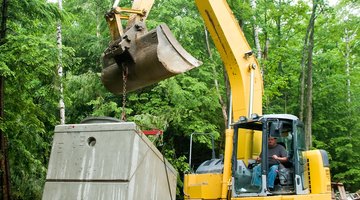How to Fill in a Deep Cistern
Empty cisterns, especially deep ones, pose a threat to people, animals and vehicles due to the danger of falling into the large receptacle. Some cisterns have open holes, making them easier to spot, while others are capped. In either case, their tops tend to decay over time, making them prone to breakage. Instead of ignoring your old cistern, it is a wise idea to fill it in. Luckily, this process is not difficult; it just takes the right equipment and some suitable filling material.

Step 1
Measure the cistern. If it is round, take measurements of the depth and diameter. If it is rectangular, take measurements for the length, width and depth. Convert fractions to decimals and plug the figures into the following calculation to determine how much fill you need:
Round: Volume in yards cubed = [(diameter x 3.14 / 4) x depth] / 27
Rectangular: Volume in yards cubed = (length x width x depth) / 27
Step 2
Remove all pipes from the cistern and plug exposed connections. Pump any remaining water using a cistern water pump.
Step 3
Dig a trench with a backhoe along one side of the cistern. Cave in one wall of the cistern with the backhoe, all the way down to the floor. This ensures that any water entering the cistern in the future will automatically leak out.
Step 4
Fill the trench and cistern with the soil dug from the trench; add other soil if necessary. Pack the soil as you fill the cistern using the backhoe. Fill the final 12 inches with top soil, dumping a little more than is necessary to accommodate settling of the soil.
Step 5
Plant vegetation similar to adjacent areas in the newly filled space so it blends in with its surroundings.
Warnings
- Always wear a safety line when entering the cistern.
- As a precautionary measure, have an assistant present at all times.
Writer Bio
As a freelance writer and editor since 2006, Kiva Bottero's work has appeared in magazines such as "Healing Path," "Green Living" and "Synergy." He started Mindful Word online magazine to explore his love of mindfulness and engaged living. Bottero holds a Bachelor of Arts in political science from the University of Western Ontario and studied magazine publishing at Ryerson University.
Photo Credits
- Jupiterimages/Photos.com/Getty Images
More Articles



